Christensen Arms seem to be one of the companies Remington never became. They continue to build appealing high-quality rifles almost around the original R700 design. This Mesa FFT has been conceived as an ultra-lightweight mountain rifle and is available in only the most purposeful and successful calibres of the past and present. Some of the popular chamberings of this rifle are being offered in true left-handed format, which will be a major selling point for Christensen. I was pleased to see how light (2.56kg/5.64lb) it really was in the almost mandatory 6.5 Creedmoor specification.
First looks strike a positive impression with a ‘Tungsten’ coloured Cerakote finish on the matt steel throughout the rifle’s barrel and action. The composite stock forms an excellent visual contrast and offers a stiff forend that fully free-floats the barrel in all conditions. There is a solidly anchored stud on the underside for a sling or bipod and I fitted a Harris, my regular review companion.
The barrel is a slender featherweight contour in stainless steel with a ½"×28 thread, tipping the 14.7mm muzzle’s neatly cut square crown without any discernible tooling chatter. The twist rate on this 6.5 Creedmoor version is one turn 1 in 8", which will stabilise common bullet weights and longer copper slugs without issue. A radial pepperpot brake is supplied for those with recoil reduction needs; it would certainly seem a desirable addition for a .300 WinMag or .300 PRC version of this light rifle, which would likely be very lively. I added the supplied RCC moderator to reduce noise, giving me an ideal UK stalking or foxing rifle setup.
Christensen give a sub-MOA guarantee, with additional reassurance from the hand-lapped finishing of this button-rifled bore with what the company refers to as a match chamber. One must assume this means close tolerances and optimised headspacing, close to exact SAAMI specifications, to improve accuracy and consistency.
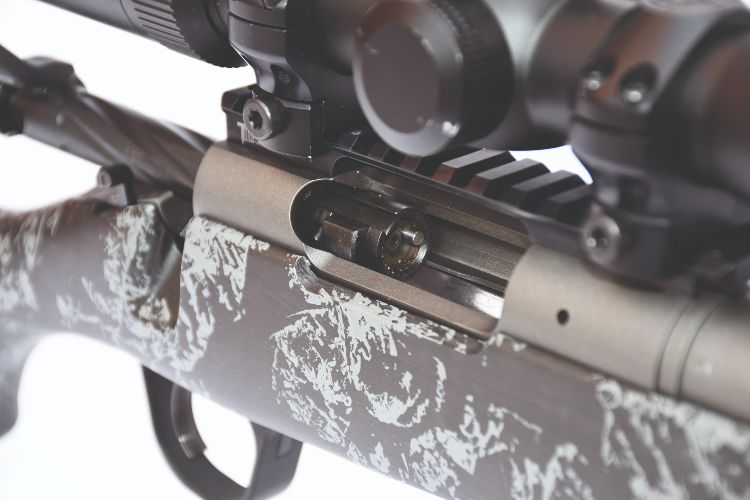 Action
Action
The action is where the Remington 700 casts the longest shadow and I don’t mean that in a derogatory way. It’s just the appreciable fact that Christensen have evolved the concept and manufacturing tolerances, where Remington have stayed almost stationary since 1962 when the rifle first appeared.
A cylindrical action supports the recoil lug, sandwiched on its face by the barrel’s tenon, with identical short or long scope mounting and stock inlet dimensions. Highland Outdoors also supplied a Tier-One Picatinny rail, along with their 30mm scope rings and a ZeroTech Optics riflescope for the review. Everything fitted precisely in position, which reflects well upon the new world of manufacturing precision all manufacturers must now deliver in order to remain competitive with their peers.
Two lugs lock the bolt into the action’s abutments, so a 90° lift opens the receiver for bolt cocking and withdrawal. The handle is 70mm long with a fluted 18mm diameter teardrop tip to the arm, which is skeletonised for weight reduction. Fluting also runs the length of the bolt shaft, which has a push-feed face and right-side extractor claw. There’s a plunger ejector and when inspecting the rear of the locking lugs you can see how they show even wear patterns from consistent, shared pressure-bearing contact under firing pressure – a good sign of precision manufacture. The bolt-release catch sits on the left side of the rear action bridge.
With the action out of the stock you can see the TriggerTech single-stage unit, which broke at a precise, crisp 1,360g/48oz. It is user adjustable from 2.5-5lb (1,130-2,260g) with simple Allen keys. And there isn’t a hint of threadlock to discourage your tuning desires. The trigger blade has a deep curve with longitudinal ribs for a sure touch.
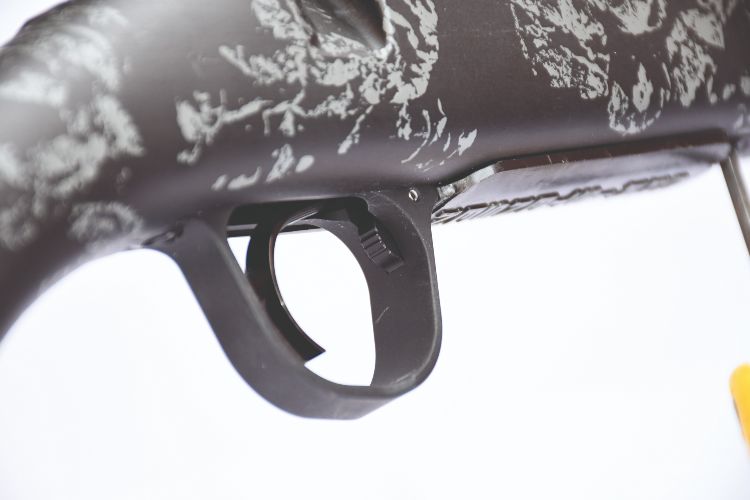 Trigger and mags
Trigger and mags
TriggerTechs are great units and I like the fact that Christensen have used them and not cut corners. The Mesa’s two-position safety catch is part of the trigger unit and is on the right side of the action just ahead of the tang. Drawing it backwards locks the mechanism; forward is for fire. Spiral fluting on the bolt’s shroud maintains the styling aesthetics.
This 6.5 Creedmoor holds four rounds in the underside floorplate, which is machined from a solid aluminium billet. When the serrated release catch inside the front of the trigger guard is activated, the contents drop into your waiting palm. The magazine system is easily loaded by pressing rounds onto the follower via the ejection port, where they descend in two staggered columns into the stock’s steel liner. The ejection port has been scalloped at the rear for improved performance when loading and ejecting.
Twin Allen screws anchor the action to the stock, spanning the floorplate, which shows a crystalline-like weave pattern to its moulding. The magazine follower is polymer to reduce ammunition damage and noticeably decreases noise as well. In use there were no stoppages or damaged bullet meplats. Each rose smoothly onto the feed ramp before entering the chamber and the broached raceways within the action are all smoothly finished without any sharp edges that could snag ammunition or your fingers when loading.
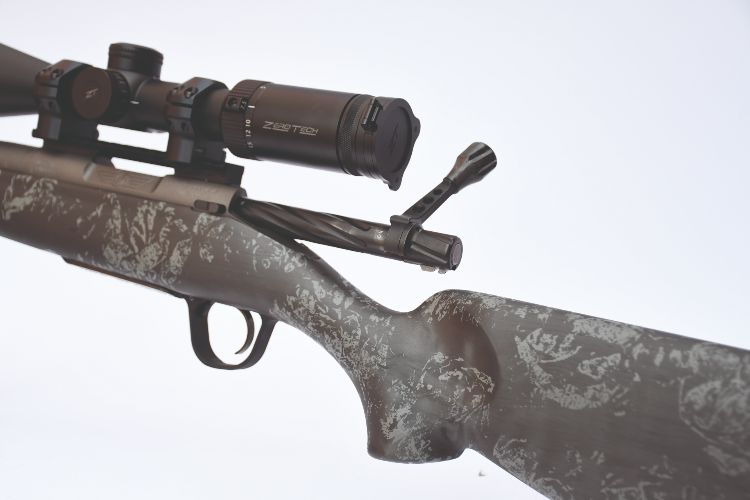 Stock
Stock
Christensen Arms’ FFT carbon fibre stock is quite delightful. Removed from the rifle is weighs a paltry 590g/20oz, which is certainly in line with the featherweight concept. Yet it shows no physical weakness and has a stiff forend that shot off a bipod without flexibility intruding on consistent barrel harmonics. Its sporter configuration is ambidextrous with a very slim, open-handed grip, yet it maintains linear recoil transfer through the stock’s wrist, into the butt, recoil pad and your shoulder without stress concentration points that are likely to invite cracks over time. Again, this is a 6.5 Creedmoor and very light for recoil. Were it a .300 WinMag it would be a far livelier gun yet still designed to cope with applied forces. As a featherweight hunting rifle it’s really designed for one shot after a long day’s hard carry, not all-day range shooting, so shooters have to accept some compromise as long as it’s not dangerous or mechanically fragile.
Stainless steel bedding pillars are fitted within the inlet and Christensen’s own description is that ‘spot bedding’ is used. The inlet looks precisely machined, yet the bedding seems to be restricted to just the recoil lug area. In fairness, the rifle exhibited none of the usual stressed action hallmarks when the action screws were released or retensioned, so I’m happy to pass it as effective and hope it is a representative example of the latest rifles.
This Tungsten version of the Mesa is finished externally in dark grey, with lighter sponge print highlights that break up the otherwise monotone appearance. I like it and think it’s a great blend of new tech and general pattern breakup without looking too aggressive. Overall it’s a matt finish and remains grippy without any additional chequering or stippling, although I didn’t get a chance to handle the gun in wet conditions.
The front sling stud is epoxy bonded into position and so, I suspect, is the rear one under the butt. Length of pull is 13.5"/343mm, which is quite short, but the recoil pad is screwed and not bonded into position, so you can feasibly add spacers. In a larger chambering the last thing you want is a cramped length of pull because getting eye relief correct is tricky and you don’t want a sniper’s eye. The recoil pad has ribs for grip into your shoulder pocket and absorbs recoil effectively as it’s a medium/soft texture but not detrimentally spongy.
The comb is slender and fits under your cheekbone, but it isn’t particularly high in terms of scope alignment, so if you do like a firm cheek weld, you will need to build it up somewhat. A Burnt Bronze Cerakote option is available instead of the Tungsten and the stock for that rifle carries green and tan colour tones.
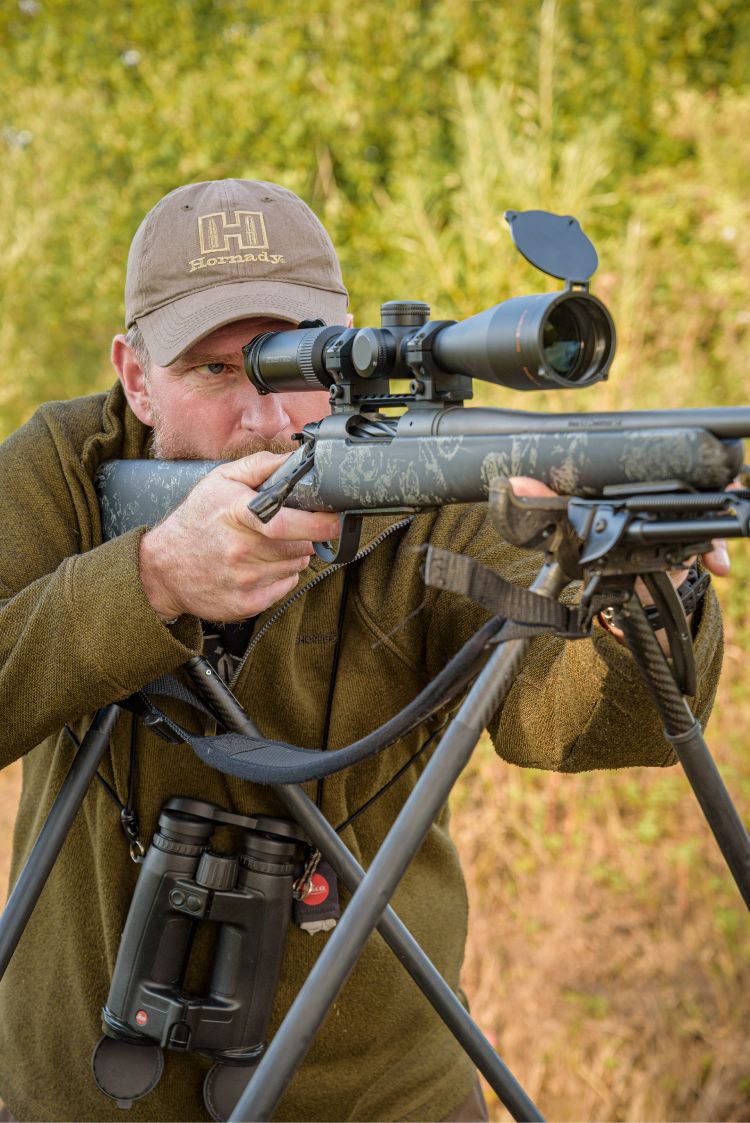 Testing the Mesa
Testing the Mesa
I trialled five ammunition types through the Mesa, with conventional copper jacketed lead, controlled expansion bullets for deer as well as varminting bullets for foxes, all from RWS and Hornady. I also tried solid copper GMX from their Outfitter and TAC ranges. I shot from the bench on a warm and windless day. This was a rifle I found easy to use with a predictable trigger and immediate capability straight from the box, shooting groups without fouling shots even though I was cleaning regularly. It’s clear that it’s perfectly realistic for the Christensen to be able to exceed its MOA guarantee.
The 90° bolt manipulation, with very little rifle disturbance through the reload cycle, and very low recoil levels, make it an easy gun to shoot. The light barrel gets hot quite quickly, so I stuck to three round groups on this hunting-oriented rifle. Recoil transit is linear to the shoulder with little muzzle jump with the RCC moderator on or off.
The short barrel gave muzzle velocities close to published figures (often measured in a 610mm/24" barrel) and picked up minimal fouling. Three wet patches and one dry would clean to my satisfaction after 20 rounds. I don’t go back obsessively to bare steel on hunting rifles; it’s too expensive to refoul the barrel and ammunition consumption is comparatively low compared with a range gun.
Christensen give detailed barrel running-in instructions on their website and it is worth following the procedure to some extent, but many shooters will have to do this over time as ammunition is naturally used for zeroing and then hunting, rather than in one range session. This rifle was apparently brand new; most review rifles are well used before they reach me, so it was nice to get a box-fresh item for a change.
| Ammo |
Weight (grns) |
Stated velocity (FPS) |
Average velocity recorded (FPS) |
Muzzle energy |
100m 3-shot group (mm/") |
| RWS Speed Tip Pro |
140 |
2717 |
2638 |
2164 |
19.4/0.76 |
| RWS Evo Green |
93 |
3214 |
3146 |
2044 |
18.6/0.73 |
| Hornady V-Max |
95 |
3300 |
3248 |
2225 |
14.8/0.58 |
| Hornady Outfitter GMX |
120 |
2925 |
2919 |
2271 |
15.1/0.59 |
| Hornady TAP GMX |
140 |
2675 |
2589 |
2084 |
11.7/0.46 |
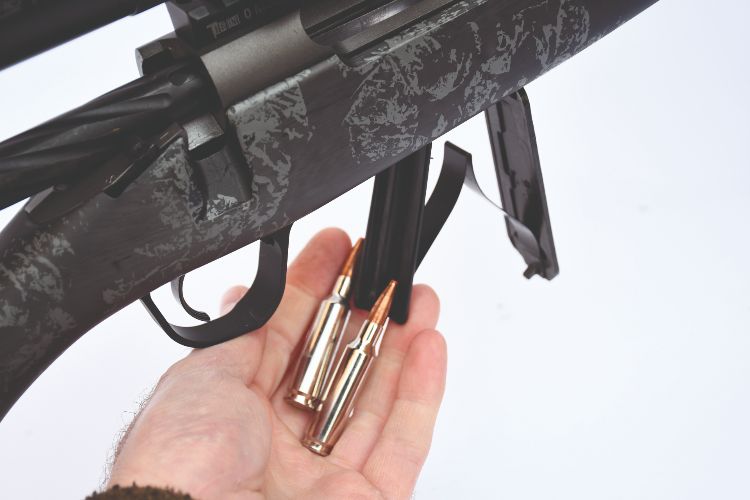 Conclusion
Conclusion
Case feed, extraction and ejection were faultless, and other than the barrel heat I enjoyed shooting the rifle. The forend is satisfactory for a good grasp without fingers or thumbs touching the barrel. Being stiff enough for bipod or other supports, it gave confidence in the gun as a hunting tool for use in all kinds of shooting/support positions. I shot the rifle from quad sticks and, although light, it balanced correctly – neutral with the brake, slightly muzzle heavy with the mod on. I did find the length of pull a bit short and would add some spacers were it mine.
The only thing I didn’t like on this rifle was the grip. It was just a bit too small for my hands. I like the fact that a left-hander is available and the overall manufacturing standards of the rifle, and its Tungsten finish, are very good. It looks great and certainly hasn’t shown any marks from the first 50 rounds through it.
This rifle makes modest claims and meets them precisely, for all the moderate handling requirements of a UK shooter. It’s a no nonsense, fundamentally proven design, and with stainless steel barrel and Cerakote finish it is likely to last a very long time. I think it’s very well priced given the exclusivity of the product.
Tech specs
Calibres: 6.5 Creedmoor on review, 6.5 PRC, 7mm-08, 28 Nosler, 7mm Rem mag, .308, .300 Win Mag and .300 PRC and .450 Bushmaster also available
Barrel length: 510mm/20" stainless steel lapped, with match chamber
Overall length: 1,000mm/39.5"
Weight: 2.56kg/5.64lb
Muzzle thread: 5/8"x24
Stock: Carbon fibre
Length of pull: 343mm/13.5"
Trigger: Single-stage breaking at 1,360gr/48oz, adjustable (2.5-5lb)
Safety catch: Two-position without bolt lock
Magazine: Aluminium/polymer floorplate, 4+1 capacity
Finish: Tungsten Cerakote/composite stock
RRPs
Mesa FFT rifle: £2,349.99
RCC F48 moderator: £240.99
ZeroTech Thrive scope: £654.99
Tier-One Picatinny rail: £89.99
Tier-One rings: £145.99
Contact
Highland Outdoors
01858 880 491